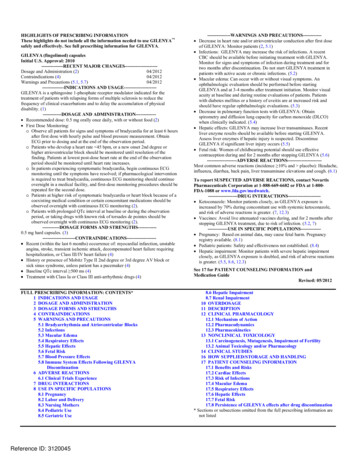
Transcription
HIGHLIGHTS OF PRESCRIBING INFORMATIONThese highlights do not include all the information needed to use GILENYA safely and effectively. See full prescribing information for GILENYA.GILENYA (fingolimod) capsulesInitial U.S. Approval: 2010--------------RECENT MAJOR CHANGES-------------------- Dosage and Administration (2)04/2012Contraindications (4)04/2012Warnings and Precautions (5.1, 5.7)04/2012--------------INDICATIONS AND USAGE-------------------- GILENYA is a sphingosine 1-phosphate receptor modulator indicated for thetreatment of patients with relapsing forms of multiple sclerosis to reduce thefrequency of clinical exacerbations and to delay the accumulation of physicaldisability. (1)------------DOSAGE AND ADMINISTRATION------------ Recommended dose: 0.5 mg orally once daily, with or without food (2) First Dose Monitoring:o Observe all patients for signs and symptoms of bradycardia for at least 6 hoursafter first dose with hourly pulse and blood pressure measurement. ObtainECG prior to dosing and at the end of the observation period.o Patients who develop a heart rate 45 bpm, or a new onset 2nd degree orhigher atrioventricular block should be monitored until resolution of thefinding. Patients at lowest post-dose heart rate at the end of the observationperiod should be monitored until heart rate increases.o In patients experiencing symptomatic bradycardia, begin continuous ECGmonitoring until the symptoms have resolved; if pharmacological interventionis required to treat bradycardia, continuous ECG monitoring should continueovernight in a medical facility, and first-dose monitoring procedures should berepeated for the second dose.o Patients at higher risk of symptomatic bradycardia or heart block because of acoexisting medical condition or certain concomitant medications should beobserved overnight with continuous ECG monitoring (2).o Patients with prolonged QTc interval at baseline or during the observationperiod, or taking drugs with known risk of torsades de pointes should beobserved overnight with continuous ECG monitoring (2).-----------DOSAGE FORMS AND STRENGTHS----------- 0.5 mg hard capsules. --------- Recent (within the last 6 months) occurrence of: myocardial infarction, unstableangina, stroke, transient ischemic attack, decompensated heart failure requiringhospitalization, or Class III/IV heart failure (4) History or presence of Mobitz Type II 2nd degree or 3rd degree AV block orsick sinus syndrome, unless patient has a pacemaker (4) Baseline QTc interval 500 ms (4) Treatment with Class Ia or Class III anti-arrhythmic drugs (4)FULL PRESCRIBING INFORMATION: CONTENTS*1 INDICATIONS AND USAGE2 DOSAGE AND ADMINISTRATION3 DOSAGE FORMS AND STRENGTHS4 CONTRAINDICATIONS5 WARNINGS AND PRECAUTIONS5.1 Bradyarrhythmia and Atrioventricular Blocks5.2 Infections5.3 Macular Edema5.4 Respiratory Effects5.5 Hepatic Effects5.6 Fetal Risk5.7 Blood Pressure Effects5.8 Immune System Effects Following GILENYADiscontinuation6 ADVERSE REACTIONS6.1 Clinical Trials Experience7 DRUG INTERACTIONS8 USE IN SPECIFIC POPULATIONS8.1 Pregnancy8.2 Labor and Delivery8.3 Nursing Mothers8.4 Pediatric Use8.5 Geriatric UseReference ID: 3120045---------------WARNINGS AND PRECAUTIONS----------- Decrease in heart rate and/or atrioventricular conduction after first doseof GILENYA: Monitor patients (2, 5.1) Infections: GILENYA may increase the risk of infections. A recentCBC should be available before initiating treatment with GILENYA.Monitor for signs and symptoms of infection during treatment and fortwo months after discontinuation. Do not start GILENYA treatment inpatients with active acute or chronic infections. (5.2) Macular edema: Can occur with or without visual symptoms. Anophthalmologic evaluation should be performed before startingGILENYA and at 3-4 months after treatment initiation. Monitor visualacuity at baseline and during routine evaluations of patients. Patientswith diabetes mellitus or a history of uveitis are at increased risk andshould have regular ophthalmologic evaluations. (5.3) Decrease in pulmonary function tests with GILENYA: Obtainspirometry and diffusion lung capacity for carbon monoxide (DLCO)when clinically indicated. (5.4) Hepatic effects: GILENYA may increase liver transaminases. Recentliver enzyme results should be available before starting GILENYA.Assess liver enzymes if hepatic injury is suspected. DiscontinueGILENYA if significant liver injury occurs (5.5) Fetal risk: Women of childbearing potential should use effectivecontraception during and for 2 months after stopping GILENYA (5.6)-------------------ADVERSE REACTIONS--------------------- Most common adverse reactions (incidence 10% and placebo): Headache,influenza, diarrhea, back pain, liver transaminase elevations and cough. (6.1)To report SUSPECTED ADVERSE REACTIONS, contact NovartisPharmaceuticals Corporation at 1-888-669-6682 or FDA at 1-800 FDA-1088 or www.fda.gov/medwatch.-------------------DRUG INTERACTIONS-------------------- Ketoconazole: Monitor patients closely, as GILENYA exposure isincreased by 70% during concomitant use with systemic ketoconazole,and risk of adverse reactions is greater. (7, 12.3) Vaccines: Avoid live attenuated vaccines during, and for 2 months afterstopping GILENYA treatment, due to risk of infection. (5.2, 7)-------------USE IN SPECIFIC POPULATIONS------------ Pregnancy: Based on animal data, may cause fetal harm. Pregnancyregistry available. (8.1) Pediatric patients: Safety and effectiveness not established. (8.4) Hepatic impairment: Monitor patients with severe hepatic impairmentclosely, as GILENYA exposure is doubled, and risk of adverse reactionsis greater. (5.5, 8.6, 12.3)See 17 for PATIENT COUNSELING INFORMATION andMedication GuideRevised: 05/20128.6 Hepatic Impairment8.7 Renal Impairment10 OVERDOSAGE11 DESCRIPTION12 CLINICAL PHARMACOLOGY12.1 Mechanism of Action12.2 Pharmacodynamics12.3 Pharmacokinetics13 NONCLINICAL TOXICOLOGY13.1 Carcinogenesis, Mutagenesis, Impairment of Fertility13.2 Animal Toxicology and/or Pharmacology14 CLINICAL STUDIES16 HOW SUPPLIED/STORAGE AND HANDLING17 PATIENT COUNSELING INFORMATION17.1 Benefits and Risks17.2 Cardiac Effects17.3 Risk of Infections17.4 Macular Edema17.5 Respiratory Effects17.6 Hepatic Effects17.7 Fetal Risk17.8 Persistence of GILENYA effects after drug discontinuation* Sections or subsections omitted from the full prescribing information arenot listed
FULL PRESCRIBING INFORMATION1 INDICATIONS AND USAGEGILENYA is indicated for the treatment of patients with relapsing forms of multiple sclerosis (MS) to reduce thefrequency of clinical exacerbations and to delay the accumulation of physical disability.2 DOSAGE AND ADMINISTRATIONRecommended DoseThe recommended dose of GILENYA is 0.5 mg orally once daily. Fingolimod doses higher than 0.5 mg are associatedwith a greater incidence of adverse reactions without additional benefit. GILENYA can be taken with or without food.First Dose MonitoringInitiation of GILENYA treatment results in a decrease in heart rate [see Warnings and Precautions (5.1) and ClinicalPharmacology (12.2)]. After the first dose of GILENYA, the heart rate decrease starts within an hour and the Day 1 nadirgenerally occurs within approximately 6 hours, although the nadir can be observed up to 24 hours after the first dose insome patients.The first dose of GILENYA should be administered in a setting in which resources to appropriately manage symptomaticbradycardia are available. In order to assess patient response to the first dose of fingolimod, observe all patients for 6hours for signs and symptoms of bradycardia with hourly pulse and blood pressure measurement. Obtain in all patients anelectrocardiogram prior to dosing, and at the end of the observation period.Additional observation should be instituted until the finding has resolved in the following situations: The heart rate 6 hours post-dose is 45 bpmThe heart rate 6 hours post-dose is at the lowest value post-dose (suggesting that the maximum pharmacodynamiceffect on the heart may not have occurred)The ECG 6-hours post-dose shows new onset second degree or higher AV blockShould post-dose symptomatic bradycardia occur, initiate appropriate management, begin continuous ECG monitoring,and continue observation until the symptoms have resolved.Should a patient require pharmacologic intervention for symptomatic bradycardia, continuous overnight ECG monitoringin a medical facility should be instituted, and the first dose monitoring strategy should be repeated after the second dose ofGILENYA.Patients with some pre-existing conditions (e.g., ischemic heart disease, history of myocardial infarction, congestive heartfailure, history of cardiac arrest, cerebrovascular disease, history of symptomatic bradycardia, history of recurrent syncope,severe untreated sleep apnea, AV block, sino-atrial heart block) may poorly tolerate the GILENYA-induced bradycardia,or experience serious rhythm disturbances after the first dose of GILENYA. Prior to treatment with GILENYA, thesepatients should have a cardiac evaluation by a physician appropriately trained to conduct such evaluation, and, if treatedwith GILENYA, should be monitored overnight with continuous ECG in a medical facility after the first dose. GILENYAis contraindicated in patients who in the last 6 months experienced myocardial infarction, unstable angina, stroke,transient ischemic attack (TIA), decompensated heart failure requiring hospitalization or Class III/IV heart failure) [seeContraindications (4)].Since initiation of GILENYA treatment results in decreased heart rate and may prolong the QT interval, patients with aprolonged QTc interval ( 450 msec males, 470 msec females) before dosing or during 6 hour observation, or atadditional risk for QT prolongation (e.g., hypokalemia, hypomagnesemia, congenital long-QT syndrome), or onconcurrent therapy with QT prolonging drugs with a known risk of torsades de pointes (e.g., citalopram, chlorpromazine,haloperidol, methadone, erythromycin) should be monitored overnight with continuous ECG in a medical facility [seeDrug Interactions (7)].Experience with GILENYA is limited in patients receiving concurrent therapy with drugs that slow heart rate oratrioventricular conduction (e.g., beta blockers, heart-rate lowering calcium channel blockers such as diltiazem orverapamil, or digoxin). Because the initiation of GILENYA treatment is also associated with slowing of the heart rate,concomitant use of these drugs during GILENYA initiation may be associated with severe bradycardia or heart block.Reference ID: 3120045
The possibility to switch to drugs that do not slow the heart rate or atrioventricular conduction should be evaluated by thephysician prescribing these drugs before initiating GILENYA. In patients who cannot switch, overnight continuous ECGmonitoring after the first dose is recommended [see Drug Interactions (7)].Clinical data indicate effects of GILENYA on heart rate are maximal after the first dose although milder effects on heartrate may persist for, on average, 2-4 weeks after initiation of therapy at which time heart rate generally returns to baseline.Physicians should continue to be alert to patient reports of cardiac symptoms.Re-initiation of Therapy Following DiscontinuationIf GILENYA therapy is discontinued for more than 14 days, after the first month of treatment, the effects on heart rate andAV conduction may recur on reintroduction of GILENYA treatment and the same precautions (first dose monitoring) asfor initial dosing should apply. Within the first 2 weeks of treatment, first dose procedures are recommended afterinterruption of one day or more, during week 3 and 4 of treatment first dose procedures are recommended after treatmentinterruption of more than 7 days.3 DOSAGE FORMS AND STRENGTHSGILENYA is available as 0.5 mg hard capsules with a white opaque body and bright yellow cap imprinted with “FTY 0.5mg” on the cap and two radial bands imprinted on the capsule body with yellow ink.4 CONTRAINDICATIONSPatients who in the last 6 months experienced myocardial infarction, unstable angina, stroke, TIA, decompensated heartfailure requiring hospitalization or Class III/IV heart failureHistory or presence of Mobitz Type II second-degree or third-degree atrioventricular (AV) block or sick sinus syndrome,unless patient has a functioning pacemakerBaseline QTc interval 500 msTreatment with Class Ia or Class III anti-arrhythmic drugs5 WARNINGS AND PRECAUTIONS5.1 Bradyarrhythmia and Atrioventricular BlocksBecause of a risk for bradyarrhythmia and atrioventricular (AV) blocks, patients should be monitored during GILENYAtreatment initiation [see Dosage and Administration (2)].Reduction in heart rateAfter the first dose of GILENYA, the heart rate decrease starts within an hour. On Day 1, the maximal decline in heartrate generally occurs within 6 hours and recovers, although not to baseline levels, by 8-10 hours post dose. Because ofphysiological diurnal variation, there is a second period of heart rate decrease within 24 hours after the first dose. In somepatients, heart rate decrease during the second period is more pronounced than the decrease observed in the first 6 hours.Heart rates below 40 beats per minute were rarely observed. Adverse reactions of symptomatic bradycardia following thefirst dose were reported in 0.5% of patients receiving GILENYA 0.5 mg, but in no patient on placebo. Patients whoexperienced bradycardia were generally asymptomatic, but some patients experienced hypotension, dizziness, fatigue,palpitations, and chest pain that usually resolved within the first 24 hours on treatment.Following the second dose, a further decrease in heart rate may occur when compared to the heart rate prior to the seconddose, but this change is of a smaller magnitude than that observed following the first dose. With continued dosing, theheart rate returns to baseline within one month of chronic treatment.Atrioventricular blocksInitiation of GILENYA treatment has resulted in transient AV conduction delays. In controlled clinical trials, adversereactions of first-degree AV block (prolonged PR interval on ECG) following the first dose were reported in 0.1% ofpatients receiving GILENYA 0.5 mg, but in no patient on placebo. Second-degree AV blocks following the first dosewere also identified in 0.1% of patients receiving GILENYA 0.5 mg, but in no patient on placebo. In a study of 698patients with available 24-hour Holter monitoring data after their first dose (N 351 on GILENYA 0.5 mg and N 347 onplacebo), second-degree AV blocks, Mobitz types I (Wenckebach) and/or II, were reported in 3.7% (N 13) of patientsReference ID: 3120045
receiving GILENYA 0.5 mg and 2% (N 7) of patients on placebo. The conduction abnormalities were usually transientand asymptomatic, and resolved within the first 24 hours on treatment, but they occasionally required treatment withatropine or isoproterenol.Post-marketing experienceIn the post-marketing setting, third degree AV block and AV block with junctional escape have been observed during thefirst-dose six-hour observation period with GILENYA. Isolated delayed onset events, including transient asystole andunexplained death, have occurred within 24 hours of the first dose. These events were confounded by concomitantmedications and/or pre-existing disease, and the relationship to GILENYA is uncertain. Cases of syncope were alsoreported after the first dose of GILENYA.5.2 InfectionsRisk of infectionsGILENYA causes a dose-dependent reduction in peripheral lymphocyte count to 20 - 30% of baseline values because ofreversible sequestration of lymphocytes in lymphoid tissues. GILENYA may therefore increase the risk of infections,some serious in nature [see Clinical Pharmacology (12.2)].Before initiating treatment with GILENYA, a recent CBC (i.e. within 6 months) should be available. Consider suspendingtreatment with GILENYA if a patient develops a serious infection, and reassess the benefits and risks prior to re-initiationof therapy. Because the elimination of fingolimod after discontinuation may take up to two months, continue monitoringfor infections throughout this period. Instruct patients receiving GILENYA to report symptoms of infections to aphysician. Patients with active acute or chronic infections should not start treatment until the infection(s) is resolved.Two patients died of herpetic infections during GILENYA controlled studies in the premarketing database (onedisseminated primary herpes zoster and one herpes simplex encephalitis). In both cases, the patients were receiving afingolimod dose (1.25 mg) higher than recommended for the treatment of MS (0.5 mg), and had received high dosecorticosteroid therapy for suspected MS relapse. No deaths due to viral infections occurred in patients treated withGILENYA 0.5 mg in the premarketing database.In MS controlled studies, the overall rate of infections (72%) and serious infections (2%) with GILENYA 0.5 mg wassimilar to placebo. However, bronchitis and, to a lesser extent, pneumonia were more common in GILENYA-treatedpatients.Concomitant use with antineoplastic, immunosuppressive or immune modulating therapiesGILENYA has not been administered concomitantly with antineoplastic, immunosuppressive or immune modulatingtherapies used for treatment of MS. Concomitant use of GILENYA with any of these therapies would be expected toincrease the risk of immunosuppression [see Drug Interactions (7)].Varicella zoster virus antibody testing/vaccinationAs for any immune modulating drug, before initiating GILENYA therapy, patients without a history of chickenpox orwithout vaccination against varicella zoster virus (VZV) should be tested for antibodies to VZV. VZV vaccination ofantibody-negative patients should be considered prior to commencing treatment with GILENYA, following whichinitiation of treatment with GILENYA should be postponed for 1 month to allow the full effect of vaccination to occur.5.3 Macular EdemaIn patients receiving GILENYA 0.5 mg, macular edema occurred in 0.4% of patients. An adequate ophthalmologicevaluation should be performed at baseline and 3-4 months after treatment initiation. If patients report visual disturbancesat any time while on GILENYA therapy, additional ophthalmologic evaluation should be undertaken.In MS controlled studies involving 1204 patients treated with GILENYA 0.5 mg and 861 patients treated with placebo,macular edema with or without visual symptoms was reported in 0.4% of patients treated with GILENYA 0.5 mg and0.1% of patients treated with placebo; it occurred predominantly in the first 3-4 months of therapy. Some patientspresented with blurred vision or decreased visual acuity, but others were asymptomatic and diagnosed on routineophthalmologic examination. Macular edema generally improved or resolved with or without treatment after drugdiscontinuation, but some patients had residual visual acuity loss even after resolution of macular edema.Reference ID: 3120045
Continuation of GILENYA in patients who develop macular edema has not been evaluated. A decision on whether or notto discontinue GILENYA therapy should include an assessment of the potential benefits and risks for the individualpatient. The risk of recurrence after rechallenge has not been evaluated.Macular edema in patients with history of uveitis or diabetes mellitusPatients with a history of uveitis and patients with diabetes mellitus are at increased risk of macular edema duringGILENYA therapy. The incidence of macular edema is also increased in MS patients with a history of uveitis. The ratewas approximately 20% in patients with a history of uveitis vs. 0.6% in those without a history of uveitis, in the combinedexperience with all doses of fingolimod. MS patients with diabetes mellitus or a history of uveitis should undergo anophthalmologic evaluation prior to initiating GILENYA therapy and have regular follow-up ophthalmologic evaluationswhile receiving GILENYA therapy. GILENYA has not been tested in MS patients with diabetes mellitus.5.4 Respiratory EffectsDose-dependent reductions in forced expiratory volume over 1 second (FEV1) and diffusion lung capacity for carbonmonoxide (DLCO) were observed in patients treated with GILENYA as early as 1 month after treatment initiation. AtMonth 24, the reduction from baseline in the percent of predicted values for FEV1 was 3.1% for GILENYA 0.5 mg and2% for placebo. For DLCO, the reductions from baseline in percent of predicted values at Month 24 were 3.8% forGILENYA 0.5 mg and 2.7% for placebo. The changes in FEV1 appear to be reversible after treatment discontinuation.There is insufficient information to determine the reversibility of the decrease of DLCO after drug discontinuation. In MScontrolled trials, dyspnea was reported in 5% of patients receiving GILENYA 0.5 mg and 4% of patients receivingplacebo. Several patients discontinued GILENYA because of unexplained dyspnea during the extension (uncontrolled)studies. GILENYA has not been tested in MS patients with compromised respiratory function.Spirometric evaluation of respiratory function and evaluation of DLCO should be performed during therapy withGILENYA if clinically indicated.5.5 Hepatic EffectsElevations of liver enzymes may occur in patients receiving GILENYA. Recent (i.e. within last 6 months) transaminaseand bilirubin levels should be available before initiation of GILENYA therapy.During clinical trials, 3-fold the upper limit of normal (ULN) or greater elevation in liver transaminases occurred in 8% ofpatients treated with GILENYA 0.5 mg, as compared to 2% of patients on placebo. Elevations 5-fold the ULN occurredin 2% of patients on GILENYA and 1% of patients on placebo. In clinical trials, GILENYA was discontinued if theelevation exceeded 5 times the ULN. Recurrence of liver transaminase elevations occurred with rechallenge in somepatients, supporting a relationship to drug. The majority of elevations occurred within 6-9 months. Serum transaminaselevels returned to normal within approximately 2 months after discontinuation of GILENYA.Liver enzymes should be monitored in patients who develop symptoms suggestive of hepatic dysfunction, such asunexplained nausea, vomiting, abdominal pain, fatigue, anorexia, or jaundice and/or dark urine. GILENYA should bediscontinued if significant liver injury is confirmed. Patients with pre-existing liver disease may be at increased risk ofdeveloping elevated liver enzymes when taking GILENYA.Because GILENYA exposure is doubled in patients with severe hepatic impairment, these patients should be closelymonitored, as the risk of adverse reactions is greater [see Use in Specific Populations (8.6) and Clinical Pharmacology(12.3)].5.6 Fetal RiskBased on animal studies, GILENYA may cause fetal harm. Because it takes approximately 2 months to eliminateGILENYA from the body, women of childbearing potential should use effective contraception to avoid pregnancy duringand for 2 months after stopping GILENYA treatment.5.7 Blood Pressure EffectsIn MS clinical trials, patients treated with GILENYA 0.5 mg had an average increase of approximately 2 mmHg insystolic pressure, and approximately 1 mmHg in diastolic pressure, first detected after approximately 1 month oftreatment initiation, and persisting with continued treatment. In controlled studies involving 854 MS patients onGILENYA 0.5 mg and 511 MS patients on placebo, hypertension was reported as an adverse reaction in 5% of patients onReference ID: 3120045
GILENYA 0.5 mg and in 3% of patients on placebo. Blood pressure should be monitored during treatment withGILENYA.5.8 Immune System Effects Following GILENYA DiscontinuationFingolimod remains in the blood and has pharmacodynamic effects, including decreased lymphocyte counts, for up to 2months following the last dose of GILENYA. Lymphocyte counts generally return to the normal range within 1-2 monthsof stopping therapy [see Clinical Pharmacology (12.2)]. Because of the continuing pharmacodynamic effects offingolimod, initiating other drugs during this period warrants the same considerations needed for concomitantadministration (e.g., risk of additive immunosuppressant effects) [see Drug Interactions (7)].6 ADVERSE REACTIONSThe following serious adverse reactions are described elsewhere in labeling: Bradyarrhythmia and atrioventricular blocks [see Warnings and Precautions (5.1)] Infections [see Warnings and Precautions (5.2)] Macular edema [see Warnings and Precautions (5.3)] Respiratory effects [see Warnings and Precautions (5.4)] Hepatic effects [see Warnings and Precautions (5.5)]The most frequent adverse reactions (incidence 10% and placebo) for GILENYA 0.5 mg were headache, influenza,diarrhea, back pain, liver enzyme elevations, and cough. The only adverse event leading to treatment interruption reportedat an incidence 1% for GILENYA 0.5 mg was serum transaminase elevations (3.8%).6.1 Clinical Trials ExperienceA total of 1703 patients on GILENYA (0.5 or 1.25 mg once daily) constituted the safety population in the 2 controlledstudies in patients with relapsing remitting MS (RRMS) [see Clinical Studies (14)].Study 1 was a 2-year placebo-controlled clinical study in 1272 MS patients treated with GILENYA 0.5 mg (n 425),GILENYA 1.25 mg (n 429) or placebo (n 418).Table 1 Adverse Reactions in Study 1 (occurring in 1% of patients, and reported for GILENYA 0.5 mg at 1%higher rate than for placebo)Primary System Organ ClassPreferred TermInfectionsInfluenza viral infectionsHerpes viral infectionsBronchitisSinusitisGastroenteritisTinea infectionsCardiac DisordersBradycardiaNervous system ointestinal disordersDiarrheaGeneral disorders and administration siteconditionsReference ID: 3120045GILENYA 0.5 mgN 425%PlaceboN 418%13987541084531412575523641127
Primary System Organ ClassPreferred TermAstheniaMusculoskeletal and connective tissuedisordersBack painSkin and subcutaneous tissue ST increasedGGT increasedWeight decreasedBlood triglycerides increasedRespiratory, thoracic and mediastinaldisordersCoughDyspneaPsychiatric disordersDepressionEye disordersVision blurredEye painVascular disordersHypertensionBlood and lymphatic system disordersLymphopeniaLeukopeniaGILENYA 0.5 mgN 425%PlaceboN 418%311274332211455351311088587431164431 1Adverse reactions in Study 2, a 1-year active-controlled (vs. interferon beta-1a, n 431) study including 849 patients withMS treated with fingolimod, were generally similar to those in Study 1.Vascular EventsVascular events, including ischemic and hemorrhagic strokes, peripheral arterial occlusive disease and posterior reversibleencephalopathy syndrome were reported in premarketing clinical trials in patients who received GILENYA doses (1.25-5mg) higher than recommended for use in MS. No vascular events were observed with GILENYA 0.5 mg in thepremarketing database.LymphomasCases of lymphoma (cutaneous T-cell lymphoproliferative disorders or diffuse B-cell lymphoma) were reported inpremarketing clinical trials in MS patients receiving GILENYA at, or above, the recommended dose of 0.5 mg. Based onthe small number of cases and short duration of exposure, the relationship to GILENYA remains uncertain.7 DRUG INTERACTIONSQT prolonging drugsGILENYA has not been studied in patients treated with drugs that prolong the QT interval. Drugs that prolong the QTinterval have been associated with cases of torsades de pointes in patients with bradycardia. Since initiation of GILENYAtreatment results in decreased heart rate and may prolong the QT interval, patients on QT prolonging drugs with a knownrisk of torsades de pointes (e.g., citalopram, chlorpromazine, haloperidol, methadone, erythromycin) should be monitoredReference ID: 3120045
overnight with continuous ECG in a medical facility [see Dosage and Administration (2) and Warnings and Precautions(5.1)].KetoconazoleThe blood levels of fingolimod and fingolimod-phosphate are increased by 1.7-fold when used concomitantly withketoconazole. Patients who use GILENYA and systemic ketoconazole concomitantly should be closely monitored, as therisk of adverse reactions is greater.VaccinesVaccination may be less effective during and for up to 2 months after discontinuation of treatment with GILENYA [seeClinical Pharmacology (12.2)]. The use of live attenuated vaccines should be avoided during and for 2 months aftertreatment with GILENYA because of the risk of infection.Antineoplastic, immunosuppressive or immunomodulating therapiesAntineoplastic, immunosuppressive or immune modulating therapies are expected to increase the risk ofimmunosuppression. Use caution when switching patients from long-acting therapies with immune effects such asnatalizumab or mitoxantrone.Drugs that slow heart rate or atrioventricular conduction (e.g., beta blockers or diltiazem)Experience with GILENYA in patients receiving concurrent therapy with drugs that slow the heart rate or atrioventricularconduction (e.g., beta blockers, digoxin, or heart-rate slowing calcium channel blockers such as diltiazem or verapamil) islimited. Because initiation of GILENYA treatment may result in an additional decrease in heart rate, concomitant use ofthese drugs during GILENYA initiation may be associated with severe bradycardia or heart block. Seek advice from theprescribing physician regarding the possibility to switch to drugs that do not slow the heart rate or atrioventricularconduction before initiating GILENYA. In patients who cannot switch, consider extended monitoring, including overnight,after the first dose [see Dosage and Administration (2) and Warnings and Precautions (5.1)].Laboratory test interactionBecause GILENYA reduces blood lymphocyte counts via redistribution in secondary lymphoid organs, periph
Experience with GILENYA is limited in patients receiving concurrent therapy with drugs that slow heart rate or atrioventricular conduction (e.g., beta blockers, heart-rate lowering calcium channel blockers such as diltiazem or verapamil, or digoxin). Because the initiation of GILENYA treatment is also associated with slowing of the heart rate,










